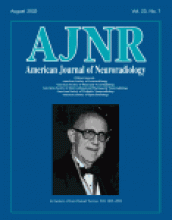Research ArticlePediatric Neuroimaging
Analysis and Classification of Cerebellar Malformations
Sandeep Patel and A. James Barkovich
American Journal of Neuroradiology August 2002, 23 (7) 1074-1087;

Submit a Response to This Article
Jump to comment:
No eLetters have been published for this article.
In this issue
Advertisement
Sandeep Patel, A. James Barkovich
Analysis and Classification of Cerebellar Malformations
American Journal of Neuroradiology Aug 2002, 23 (7) 1074-1087;
Jump to section
Related Articles
- No related articles found.
Cited By...
- Neuroradiologic, Clinical, and Genetic Characterization of Cerebellar Heterotopia: A Pediatric Multicentric Study
- Cerebellar Heterotopias: Expanding the Phenotype of Cerebellar Dysgenesis in CHARGE Syndrome
- Variable brain phenotype primarily affects the brainstem and cerebellum in patients with osteogenesis imperfecta caused by recessive WNT1 mutations
- Normal Fetal Posterior Fossa in MR Imaging: New Biometric Data and Possible Clinical Significance
- Long-term developmental outcome of children with a fetal diagnosis of isolated inferior vermian hypoplasia
- Inherited Cerebellar Ataxia in Childhood: A Pattern-Recognition Approach Using Brain MRI
- Pontocerebellar hypoplasia type 1: Clinical spectrum and relevance of EXOSC3 mutations
- GPR56-Regulated Granule Cell Adhesion Is Essential for Rostral Cerebellar Development
- Mid-brain molar tooth sign: expanding the clinical spectrum
- Recent advances in the molecular pathology, cell biology and genetics of ciliopathies
- Mid-brain molar tooth sign: expanding the clinical spectrum
- Predominant dystonia with marked cerebellar atrophy: A rare phenotype in familial dystonia
- Magnetic Resonance Imaging of the Kinked Fetal Brain Stem: A Sign of Severe Dysgenesis
- Imaging the child with developmental delay
- The magnetic resonance revolution in brain imaging: impact on neonatal intensive care
- Mutations in the oligophrenin-1 gene (OPHN1) cause X linked congenital cerebellar hypoplasia
This article has not yet been cited by articles in journals that are participating in Crossref Cited-by Linking.
More in this TOC Section
Similar Articles
Advertisement











